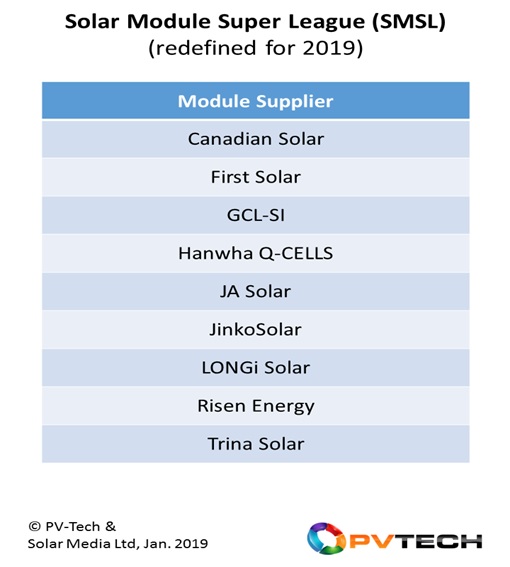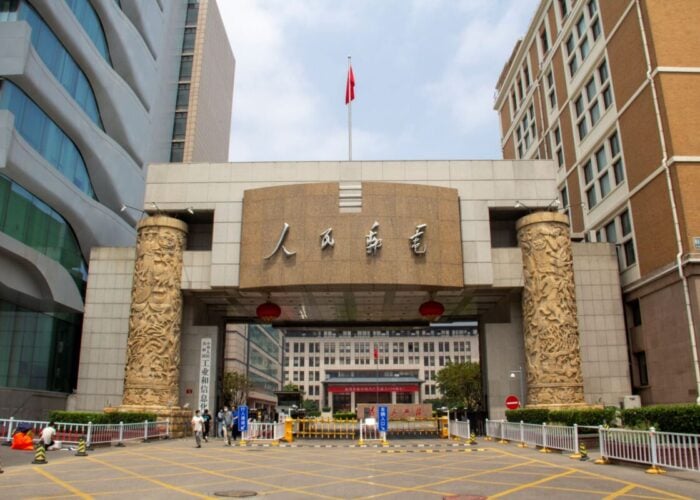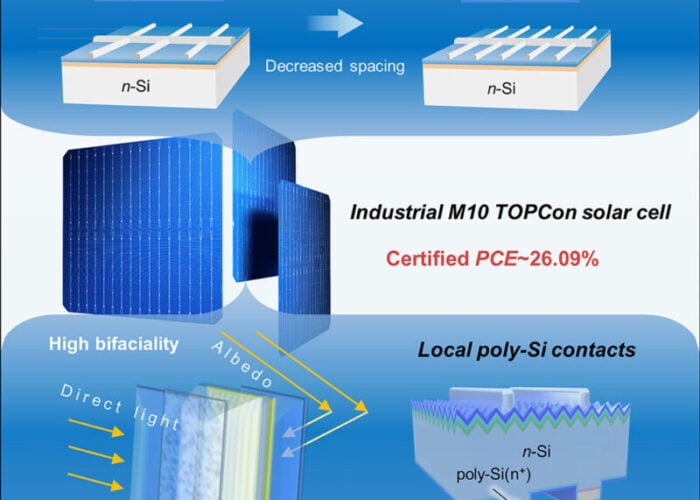
When we established the Silicon Module Super League (SMSL) a few years ago, it was prompted by the realisation that a select group of solar PV module suppliers were moving away from the 100+ chasing pack, and firmly establishing themselves as the companies that would be the dominant players as the industry moved towards and above annual shipment levels of 100GW.
In the intervening period, we subsequently added and removed companies, allowing us to ring-fence a select group of companies that were supplying about half of the industry with final module products.
Try Premium for just $1
- Full premium access for the first month at only $1
- Converts to an annual rate after 30 days unless cancelled
- Cancel anytime during the trial period
Premium Benefits
- Expert industry analysis and interviews
- Digital access to PV Tech Power journal
- Exclusive event discounts
Or get the full Premium subscription right away
Or continue reading this article for free
Indeed, the list quickly became far more useful than we had originally intended, with this group of companies supplying more than two-thirds of all modules used in large-scale projects for which the module supplier and the module technology in question is subject to technical and financial due-diligence tests by third-party agencies.
As a result, our list of companies in the SMSL became the de-facto list of top module suppliers that would typically be short-listed by investors/banks that were financing plant capex, or were the ultimate owners of the intended completed assets.
It is now time for us to refresh the SMSL entry conditions, and correspondingly re-evaluate the number of companies that will form the SMSL for 2019.
This article outlines the full list of companies forming the new SMSL for 2019, including a necessary tweaking of the nomenclature underpinning the SMSL abbreviation.
Solar Module Super League
The SMSL was formed in 2015, and included six companies: Canadian Solar, Hanwha Q-CELLS, JA Solar, Jinko Solar, Trina Solar, and Yingli Green. Early in 2016, GCL-SI replaced Yingli Green, as outlined in a feature article on PV-Tech.org here. Then in July 2016, we elevated LONGi Solar into the SMSL, creating a group of seven companies that have been the SMSL focus until now.
It should be noted that our creation of the SMSL was somewhat a by-product of simply highlighting the breakaway status of leading c-Si based module suppliers several years ago. Silicon Module was then a direct indication that only silicon-based module suppliers were in this upper echelon of industry supply levels.
However, moving forward, we have been forced – thanks to First Solar – to tweak the SMSL definition to become Solar Module Super League. This is of course rather pedantic by nature, but worth spelling out. We will continue to simply refer to the grouping as the SMSL!
Actually, during 2019, we intend to expand the generic SMSL methodology. This is now explained in the following sub-section.
Tearful prognosis of tier grouping misnomers
Amazingly, it is almost ten years ago that I wrote an article for PV-Tech about how the solar industry would be better off with Tier categories, having observed this as somewhat common practice in adjacent technology sectors.
Of course, little did I think that shortly after, a controversy would engulf the industry as to why company ‘X’ was Tier 1 but company ‘Y’ was not? Or why some companies assigned to be Tier 1 had barely 100MW of module-only capacity in-house?
Or why some companies that were clearly among the most ‘bankable’ in the PV industry and had been used in multi-GW of institutional-investor funded projects were also absent from certain lists posted in the public-domain.
Some observers would also question if the Altman-Z scoring methodology had much relevance to the solar industry, and should be part of any analysis on solar module producers/suppliers.
The Altman-Z scoring was originally configured as a means of extracting common financial metrics and doing a statistical-derived weighted analysis to highlight imminent bankruptcies. Hardly a tool for judging which modules to buy tomorrow!
Of all the questions I have had in the last decade, by far the most frequent and passionately articulated has centred on the company-listing inclusion used by different parties for tier-level categorization of solar companies.
The reason for all this narrative is because an increasing number of people have been using the SMSL as a more real-world assessment of which module companies are the true bankable suppliers of utility scale solar installations globally.
This was definitely not meant to be the role of the SMSL! But I can certainly see how the simplicity and transparency of SMSL categorization is attractive to so many people.
I think the argument here could be based on the straightforward conclusion that if a small group of companies are clearly and consistently supplying most of the major large-scale sites globally, they are by default the most bankable. It is not a bad assumption, and many would argue that reality trumps any competing academic theories any day of the week.
Having set up the SMSL, and seeing this gain traction in many quarters, it begs the question of whether this ‘League’ should have some kind of lower listing.
Anyway, this is work-in-progress, but it is motivated by the fact that there are probably about 20-30 credible module suppliers that compete as bankable for large-scale global utility-based solar today, and the new SMSL, as shown below, is confined to just nine.
The new SMSL
Starting in 2019, we are setting the bar at a minimum of 5GW of company-branded global module shipments expected in 2019. This turns out to be a good marker, as the group of companies in this bracket is well-defined; another prerequisite of the SMSL grouping itself.
The graphic below reveals the new SMSL companies, all of which were featured on our recent Top-10 Module Suppliers in 2018 article on PV-Tech.

Why the SMSL matters when looking global, non-China and utility-focused
It is worth noting first that none of the nine SMSL companies has yet to issue any guidance for module shipment levels during 2019, and even when this comes (at least from the few companies left reporting on NASDAQ/NYSE), we can of course expect a fairly wide range to be given, tinged with a dose of expectation-dumbing or sandbagging.
Rather, our current forecasted shipment levels for the SMSL companies (and indeed our forecasts for the other 10-20 other GW level module suppliers with appreciable business outside China) is based on 2018 shipment levels, traction in end-markets that have positive growth dynamics, and assessing trends in the past couple of years regarding in-house capacity levels and third-party OEM-use.
Lastly, good old-fashioned (human) engagement with all the companies still remains our most valued means of checking historic and future shipment levels and related geographic segmentation.
Now let’s look more at some of the consolidated data from the new SMSL grouping that firmly shows why this grouping is the most important part of the industry this year.
During 2019, the SMSL is forecast to ship 73-74GW of modules, of which 63-64GW will be made in-house with the remainder coming from third-party OEMs (mostly either in China or Vietnam from subservient partners).
Representing almost 60% of global module shipments in 2019, the contribution from the new SMSL can be seen to grow annually over the past years.
For example, back in 2013, this SMSL grouping supplied just 27% of global modules, reaching the 50% mark in 2016, and seeing single-digit percentage growth annually out to the forecast given here for 2019.
As highlighted earlier in the article, the dominance of the SMSL becomes more pronounced when we remove China shipments and then restrict shipments to large-scale ground-mount projects. With these filters applied, the 60% moves closer to 80%, this is therefore in territory that fully supports the SMSL designation as being among the closest today when looking at module supplier bankability.
Most of the SMSL companies will be presenting company technology roadmaps at the forthcoming PV CellTech 2019 event in Penang, Malaysia on 12-13 March 2019. Details on how to register to attend can be found here.





